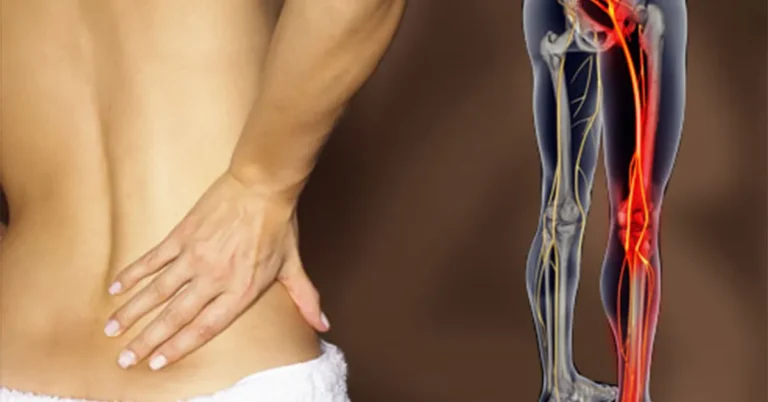What is sciatica?
What is sciatica? Our first problem. Patients (and a number of healthcare professionals!) tend to believe the following:
- Any pain in the leg coming from the back is sciatica
- It is caused by pressing the sciatic nerve
- The pressure comes from a slipped disc
- The nerve is trapped and needs freeing, so a quick manipulation will free it and hey presto!
- If it does not get better in a few weeks they may need surgery
- The problem will now recur for the rest of their lives.
So lets answer some of these before we proceed further
- Pain is often referred from an injured tissue to another area. It is termed referred pain. Therefore the pain in the leg may stem from a back problem but that does not always predict any nerve injury/damage such as the sciatic nerve. Hence not all of these are sciatica but in medicine it is the commonest description of leg pain that comes from the back area.
- There are other nerves such as the femoral nerve which can cause leg based nerve pain and nerve pain does not always stem from pressing or compression as we call it.
- Pressure on a nerve may be from a prolapsed disc or simply the hole the nerve comes from can be narrowed (we call that stenosis). The term slipped disc gives an impression that does not really equate to reality. It does not slip but ooze (and that can only happen when your discs are young enough to still be gel like).
- The nerve may be pressed but it is not trapped. All nerves can be pressed without symptoms, pain depends upon the level of pressure and whether it is severe enough to be deemed a threat to your body. Poke around the elbow gently and you will likely press the ulnar nerve and feel nothing, but bang your elbow hard in the wrong place and you will not find it funny even if everyone else does! In sciatica a nerve may be sensitised and unable to stand the same levels of pressure it puts up with every other day in your life. If its not trapped then we can’t manipulate it free and we definately can’t put the ‘slipped disc’ back in its place. Ever tried putting the toothpaste back in its tube when you have squeezed too much?
- Typically the majority of sciatica problems will resolve but they are slow to do so when compared to simple mechanical back pain. Most will resolve in 3 to 6 months (but usually the worst symptoms don’t last too long). You may need a scan at some point to help us decide whether a specific level of the spine is to blame and to see whether injections or surgery may be a treatment option to help you manage the problem. But surgery is not always the quickest and definately not always the easiest option.
- Back pain is common and people will sometimes get multiple bouts of it during their lives. Sometimes the problem is that the brain remembers how awful an experience is and the body remains vigilant for anything similar in the future. So recurrences can be painful but short lasting blips, but normalising movements and behaviours will help reduce the likelihood of these.
We call sciatica either nerve root irritation or radiculopathy
As this problem can occur anywhere in the spine and not just the lower back/sciatic nerve we call it a nerve root irritation or radiculopathy. It commonly occurs in the neck also, but thats another blog! As we have said previously, nerves can withstand pressure without any symptoms but once a threshold (which can different due to various levels of sensitivity) has been exceeded you get the symptoms commonly referred to in sciatica.
- Nerve pain is often a sharp lancing hot electrical pain and is often ranked by patients as the worst pain they have ever felt. On our scale of 0-10 it tends to rank very highly and is distressing for sufferers. Unfortunately other types of pain can hurt just as much, so simply having high levels of pain does not help us diagnose or treat it.
- In specific areas of the lower leg sufferers get parasthesia or numbness (pins and needles is often the closest description we get). In order to get these the nerve must be pressed (we term it impinged) and therefore cause it to react. Some sufferers have the pain and not the parasthesia and this is clinically difficult to diagnose as for a nerve to be compressed significantly, there must be an effect on sensation, power or reflexes.
Will I need an MRI Scan?
This may prove useful with longer term problems and can help to decide upon future management, but it does not always help us. Significant numbers of us who have no pain or parasthesia already have disc bulges that may compress the nerves (80% 0f 50 years olds!). This is because the process has occurred gradually (through normal aging) and not as a result of a sudden movement. The body may not deem it a threat and therefore ‘No threat No pain’. When it does deem it a threat, then it can be excruciating. Deciding to have a scan is a decision best made with lots of thought and discussion with your physiotherapist- will it change management- will it help confirm the diagnosis- will it make you more or less anxious?
Will I need surgery?
Most people resolve naturally, some need management/guidance from a physiotherapist and some decide to have surgery. But results show that even for more severe disc prolapses with significant impingement of the nerve, the painful symptoms will usually resolve as well without as with surgical intervention.
The quick fix?
Scientific evidence is clear, the body will eventually sort itself out and that the management of sciatica has many contributing elements. But we would never suggest their is a single method to fix it or that it is quick!
If you are in pain and in need of help then give us a call on 0131 478 4646 or book an appointment online.




